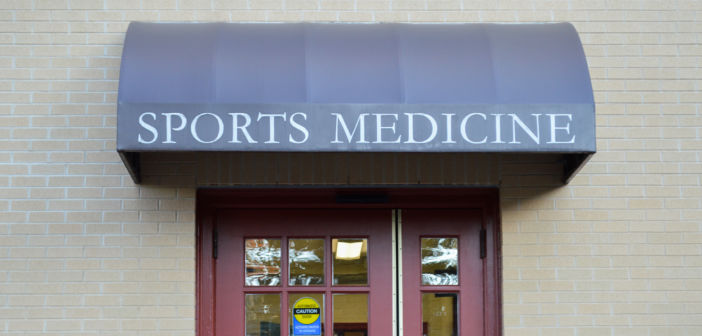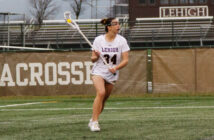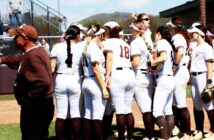She tore her right ACL on the soccer field during her junior year of high school. About one year later, she re-tore the ligament — just a month after she started playing again. Four games into her first season as a college player, she tore the ACL in her left knee, and sat out the season.
Meet Lehigh sophomore defender Kathryn Jacobellis.
He tore his right ACL on the basketball court when he was a freshman, one month after his collegiate athletic career began. About one year later, just a month after he was cleared to play, he re-tore the ligament.
Meet Lehigh junior center Caleb Sedore.
She tore her right ACL on the lacrosse field during her senior year of high school. Exactly one year later, she re-tore the ligament during her first collegiate season.
Meet Lehigh senior — and former athlete — Mel Durbin.
Three Lehigh student athletes, seven ACL tears between them. And this isn’t even a comprehensive list.
Livestrong statistics indicate that an average of 150,000 people tear their anterior cruciate ligament, or ACL, each year in the U.S. That’s about 411 ACL injuries per day. This structure is one of four main ligaments connecting the femur to the tibia, essentially holding the leg together.
The reality is while some people may be predisposed to tears depending on their individual circumstances, there isn’t one type of person who succumbs to ACL tears. ACL injuries aren’t 100 percent preventable for any athlete in any sport.
For each of these three Lehigh athletes, the first time they tore their ACL was also the first time they’d experienced a significant injury. However, they knew something was seriously wrong from the momentary burst of extreme pain that accompanied each tear.
They said while the first time was heartbreaking, the second was devastating.
“I didn’t really know what was happening,” Jacobellis said. “I was more scared of what could happen because I’ve heard about ACL tears, but never really thought that it would happen to me.”
She said she remembers being filled with self-doubt after her second tear, thinking she couldn’t go through it again and asking why it kept happening to her.
After her third tear, Jacobellis thought her scholarship would be rescinded, taking with it the chance for her to play soccer again at Lehigh.
All three Lehigh athletes, and many other athletes who have endured ACL tears, now have permanent reminders of their injuries in the form of foreign objects in their knees replacing ligaments and the scars left behind by surgeries.
Cause of injury
Mike Price, the administrative team leader of Coordinated Health’s Bethlehem campus, works closely with Lehigh’s Sports Medicine and Strength and Conditioning departments as one of the school’s rehab consultants.
Price, a physical therapist, works with athletes who are in need of long-term care. He said an athlete who tears their ACL is almost guaranteed to be out for the season and out of the sport for six to nine months minimum.
Most ACL injuries Price deals with come from football, women’s soccer, women’s basketball and women’s lacrosse.
“Sports that lead to high rates of stop-start or cuts, that’s where you’re more prone to the injury,” Price said.
Livestrong figures show that 70 percent of these tears happen in a non-contact injury, meaning the forces, angles, weight and changes of direction of the athlete’s own body cause the ligament to rip. The other 30 percent of tears are contact-related, as a result of tackles or other collisions.
Jacobellis, Sedore and Durbin succumbed to each of their injuries during points of non-contact, whether it was by landing or planting wrong during games or practices or due to a shift in the weight placed on each knee.
Likelihood of injury based on gender
Price works with five to eight Lehigh athletes with torn ACLs per semester. Jacobellis is one of those injured athletes rehabbing through Coordinated Health, where athletes typically complete the first stage of the process.
Price said his all-time high was a few years ago when he saw 11 to 12 tears in one semester, the majority of which were sustained by female athletes.
According to Catharine Rudio, Lehigh’s assistant director of Sports Medicine, there’s a reason for this.
“Unfortunately, there’s a lot of research that will show that females are a little bit more predisposed to non-contact ACL injuries due to a variety of reasons,” Rudio said.
Livestrong data suggests women could be as much as eight times more likely to tear their ACLs than men.
Because the female body is designed for childbirth, women’s pelvises are wider than men’s. Price said the angles created between the hips and knees are also wider for females, so when both structures move at larger angles, it creates a higher likelihood of tearing.
In addition, Price said women’s ligaments are looser than men’s, giving females more joint movement and flexibility than males, but also putting them at a higher risk for injury.
He said women have more of an imbalance between the strength of their quads and hamstrings, tend to bend their knees less when landing off a jump and run more upright than men. This causes female athletes to have a higher chance of falling to forces that could tear their ACLs.
In a survey of 51 athletes conducted by The Brown and White, 14 participants, or 27.45 percent, tore their ACL at least once. Eleven, or 78.57 percent, of these injured athletes were women.
Lehigh’s assistant strength and conditioning coach, Dom Carlineo, said female basketball players suffer the most ACL injuries. He said because they’re taller and longer than other athletes, their range of motion is more vulnerable, further predisposing them to ACL tears.
Graduate student and former Lehigh women’s basketball player Kari Moffat said during the course of her four years at Lehigh, three of her teammates tore their ACLs a collective four times, and two more have fallen to the injury so far this year.
Prehab and surgery
Price said once an athlete tears their ACL, their leg swells and fills with blood, which is a naturally sticky fluid and restricts movement.
He said the majority of athletes undergo the prehab process — which lasts from a few weeks to a month, depending on the athlete and injury — prior to surgery to regain normal motion or movement by bending their injured knee. Rudio said the process also gives the knee time to decrease swelling and pain.
Jacobellis, Sedore and Durbin went through prehab a total of six times before having ACL surgery, one of two or three knee-related surgeries Price said he sees the most in the field.
Price said the decision to undergo surgery is a personal one. However, sports that require jumping, cutting, running and quick stop-starts require a stable knee.
“If you want to lead an active lifestyle and play sports, you need to have your ACL done,” he said.
Price described the ligament as a seat belt. He said just as there are risks involved in driving a car without a seat belt, playing without an ACL is just as dangerous.
Rachel Kennedy, Lehigh’s associate director of Sports Medicine, said this is also a risk not many athletes are willing to take.
“There’s very few sports that I’ve seen athletes be able to successfully participate without it,” Kennedy said.
The three Lehigh athletes underwent surgery each time they tore their ACL.
Sedore said forgoing surgery wasn’t an option if he planned to get back on the court.
The rehab process
Within 48 hours of surgery, Price said athletes begin the rehab process, the stages of which Kennedy said are designed based on the healing process. During the first one to two weeks, the goal is to extend the leg to a straight position and bend the knee normally.
Price said earlier in the process, rehab emphasizes range of motion, strength of thigh muscles and balance. Further down the road, the focus turns to athletes feeling comfortable on their feet, shifting their weight and retraining their legs to respond to changes in direction of their bodies.
Just as Jacobellis, Sedore and Durbin did, Rudio said athletes typically undergo rehab through Sports Medicine, which works hand-in-hand with Strength and Conditioning and Coordinated Health.
Kennedy said there are benefits to undergoing rehab through the university because its physical therapists understand the nature of Lehigh sports, and athletes are able to participate in rehab more regularly.
Carlineo said it’s important to know what an athlete has been through to know where to lead them.
Once athletes pass Sports Medicine’s recovery phase, Carlineo said the next phase is completed through Strength and Conditioning and is more hands-on.
“It’s like a car coming into a shop,” he said. “It can run, but not well. And we need to find out what we need to strengthen, what we need to fix, to get them back to game speed. Sports Medicine gets them back on their feet. We get them back to their sport.”
At the end of the line, Kennedy said Lehigh’s head orthopedic physician has the final clearance. To be cleared, she said athletes must have full range of motion, as well as adequate strength and ratio of strength, so they can equally balance the involvement of their injured and uninjured sides.
Carlineo said strength, power and agility are the byproducts of mental toughness, one of two goals he has for athletes he works with. The other is injury prevention.
“I was tough, but not smart in my toughness, so I always got hurt,” he said, “and that was how I learned how to train kids not to get hurt.”
Carlineo said it’s not about how much weight you move, how high you jump or how fast you run. He said it’s about working smart and bringing that onto the field, court or turf. Athletes are more prone to injury when they aren’t putting in and committing 100 percent.
While Carlineo admitted nothing is completely preventable, he said Strength and Conditioning focuses on minimizing injuries and preparing athletes for any force they’re exposed to in their sport.
In his time working with Lehigh athletes, Price said each athlete found their way back to the same level of play they were at prior to their injury.
“That’s the goal, and I’d say we’re pretty much always successful in that if that’s what the athlete wants,” Price said.
Life after injury
Jacobellis plans to return as a starter next fall and said she’s considering taking a fifth year. She said coming in as an injured freshman put her at a disadvantage, and adjusting to playing on the team was hard for her because her teammates already knew and worked well with each other.
She added it’s been painful for her to watch games from the sidelines, but she’s looking forward to getting back on the field with her team.
“It definitely made me humbler in a way,” Jacobellis said. “It made me appreciate the sport more for sure. It made me appreciate people who don’t play, people who play. Everyone has a role on the team no matter what.”
Sedore is now cleared for everything non-contact, is starting to introduce some contact and looks to fully return to the court sometime this year, finishing the season on two feet for the first time in his Lehigh athletic career.
“It hurts not being able to play,” Sedore said. “Basketball is something I’ve played my entire life. Once you play something or do something for your entire life, it kind of becomes part of your identity. Not having that as part of my identity for two years, it was just a weird thing — identity crisis in a way.”
Sedore said he struggled with not being able to bear weight after his injuries, needing help completing simple tasks such as showering and getting dressed and feeling separated from the team at times.
He said despite the fact that two ACL tears are a tough road to come back from, he never considered quitting and believes he was able to get mentally and physically stronger in the process. He attributes still being on the team to the support he received from his teammates.
Kennedy said athletes who have torn their ACLs multiple times are the ones who start to think about retiring because of the possibility of re-tearing. Price said these athletes have to consider the risk-reward of going through the long, demanding process of rehab again.
Carlineo said after athletes are sidelined for so long, sometimes it’s just not worth it for them to continue with the sport.
“A big thing we preach here is despite the strength, explosion, agility, success, trophies, championships — you’re only competing until you’re 20-something,” Carlineo said. “You need your knees for a long time.”
Durbin spent the rest of her freshman year and her entire sophomore year going through rehab and recovering. She spent more time at Lehigh rehabbing than playing.
“It definitely taught me a lot about how some things are just out of your control and for the best, and you just have to make the best of the situation you’re in because complaining doesn’t really help anything,” she said.
After realizing her knee wouldn’t hold up anymore, Durbin quit the lacrosse team the first week of her junior year.
Moffat said ACL tears also take an emotional and mental toll on the injured athlete’s teammates and coaches. She said the basketball team would often end practice early when a player tore their ACL, but the hardest part was when the team had to finish a game after losing a teammate to an injury and watching the injured player being taken off the field.
Moffat said teams have to play for injured players with the knowledge they may never compete again.
“It is a minuscule part of your knee,” she said, “but it takes such a massive toll.”






Comment policy
Comments posted to The Brown and White website are reviewed by a moderator before being approved. Incendiary speech or harassing language, including comments targeted at individuals, may be deemed unacceptable and not published. Spam and other soliciting will also be declined.
The Brown and White also reserves the right to not publish entirely anonymous comments.